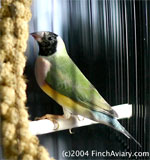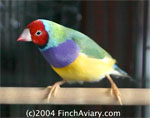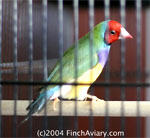|
THE
BIRDS IN OUR AVIARY
|
||||||||||||||
|
|
|
|||||||||||||
The Lady Gouldian Finch ***NEW!*** Well, they are finally here! The new Lady Gouldian Finches have arrived! I purchased them today, May 08, 2004, at the GCCBC Spring Bird Fair. I purchased them from the same breeder as my blue caps and my owls. The female is a black headed purple breast normal. She is just about done coming into color, but not completely, hence the mottled appearance of the black on her face. The male is a red-headed purple breasted normal. They are both beautiful and active little ones. I couldn't be more delighted with them. I've really missed having the Gouldians around. They apparently have been named Duck and Bill by my three-year-old son - who was coaxed into naming them by my husband. Best guess is Duck and Bill come from two somewhat obscure trains in the Thomas the Tank Engine series. I can't say I'm crazy about the names, but now that Zach's named them, my husband is committed to making the names stick. So Duck and Bill it is. Or Duckie and William? We shall see. Upon introduction to the quarantine cage, the female flew out of the box immediately and headed straight for the highest perch and the millet spray. The male was more cautious, but within a few minutes was up on the highest perch courting the female with his song and dance. He is obviously quite taken with her, because he's been singing on and off throughout the day. To the left are the first pictures of these wonderful little birds. As you can see, they are under quarantine, hence the cage bars. Better pictures will be available when they can be introduced into the aviary. Hopefully, their quarantine will be uneventful - I know they will just love the spatious aviary. Once in the aviary, you will be able to look for them on the AviCam, and I will make new wallpapers available at that time as well. Prior to acquiring this pair, the aviary was home to two other Gouldian finches, Mr G and Mrs G, no longer with us. Mr. G. was a red-headed dilute, purple-breasted male Lady Gouldian Finch who was NFSS-banded in 1996. Mrs G was not banded and was a black-headed purple breasted normal. Gouldians are by far the most brightly colored finches in captivity. There are many color mutations, but I prefer the dilute and normal colors the best. I am especially partial to red-headed males and black-headed females, as you might be able to guess by mychoice of birds, both present and past. Gouldians are another excellent aviary bird. They have shown no signs of aggression and they provide a focal point to the aviary. Mr. G. was the first finch noticed by company seeing my aviary for the first time. I do find the gouldian finches to be a little more withdrawn or stand-offish than the other birds. They rarely sit in physical contact with another bird and are not ones for cuddling, snuggling, or affectionate preening. Mine also never took to a bath and are very finicky eaters. Mr. G. was the worst eater of the bunch, loving millet sprays and seed (and the occasional pellet snack), but shunning just about everything else. Gouldians prefer to sleep on a perch (the higher the better) at night, unless they are sitting on eggs. Gouldians are sexually dimorphic. Females are usually exhibit a paler shade of color on the breast and underside. Males also sing a very very soft song while standing erect on the perch and bouncing up and down. Females usually do not sing, but only emit a short chirp. Gouldians get a bad rep in many books on finch-keeping. They are described as "delicate" and inexperienced potential owner's are scared away by warnings that they could "drop dead at a moment's notice" and that they are extremely sensitive to temperature and humidity. I have not found this to be true at all. My Gouldians have never required any special care and they don't seem any more sensitive than any of the other birds in the aviary. They also have a reputation of being difficult to breed, particularly with regard to tossing babies. Although I do not breed, I have heard that this behavior is typical of many young Gouldians, but they frequently outgrow this behavior by the next breeding season. Click Previous to return to the Masked Grassfinch's page. Click Next to advance to the Strawberries' page. |
|
|
|
|
|
HOME | CONSTRUCTION
| CARE | BIRDS
| ACCESSORIES | BACKGROUND
AVICAM | GALLERY
| GUESTBOOK | LINKS
| SEARCH
SITE MAP | DISCLAIMER
| CONTACT US
(c)2005 FinchAviary.com



